Maryland's Solar Resources
This unit of the Solar Market module explores the primary sources of energy, energy conversions between different forms of energy, and the total energy reserves available for our use. Differentiation is made between renewable and nonrenewable energy, as well as thermal and electric energy. By the end of this unit, you will be able to describe the invention and progress of photovoltaics, identify the primary sources of energy conversions, and describe the relative size of the solar resource compared to traditional energy sources.

Energy Conversions & Pathways
Energy exists in several different forms including heat, light, chemical, mechanical, and thermal energy. These different forms of energy can also be converted from one form into another. Photosynthesis is one example in which plants convert solar energy into chemical energy. Another practical example is the burning of wood or biomass which converts the chemical energy contained in the biomass into both heat and light energy. Coupling both of these examples together, as shown in Figure 1, demonstrates how the heat and light energy created by the stove can be traced all the way back to solar energy. These are only a few examples of energy conversions, but there are many more.

The fundamental starting point of all energy conversions is commonly called a primary energy source. In the previous example, the Sun represented the primary energy source in which all subsequent energy conversions initiated. Additional energy conversion pathways that originate from the Sun are depicted in Figure 2. The top two pathways represent energy conversions involving biogenic (or living) resources which convert energy through photosynthesis. This includes wood and other plant matter that may be converted into useful chemical energy such as ethanol and biodiesel. Under different conditions, those same photosynthetic products can be converted to energy dense fossil fuels (such as coal, crude oil, and natural gas) through long geological processes. Coal, natural gas, and petroleum are called fossil fuels since they are formed over thousands of years from the buried remains of ancient plants and animals. Heat and light energy from the Sun can also be used indirectly by harnessing and converting the energy produced by solar-induced weather events, including wind, waves, precipitation and running water. The same heat and light energy from the Sun can be directly used in solar thermal or photovoltaic applications, the latter of which is the focus of this handbook.
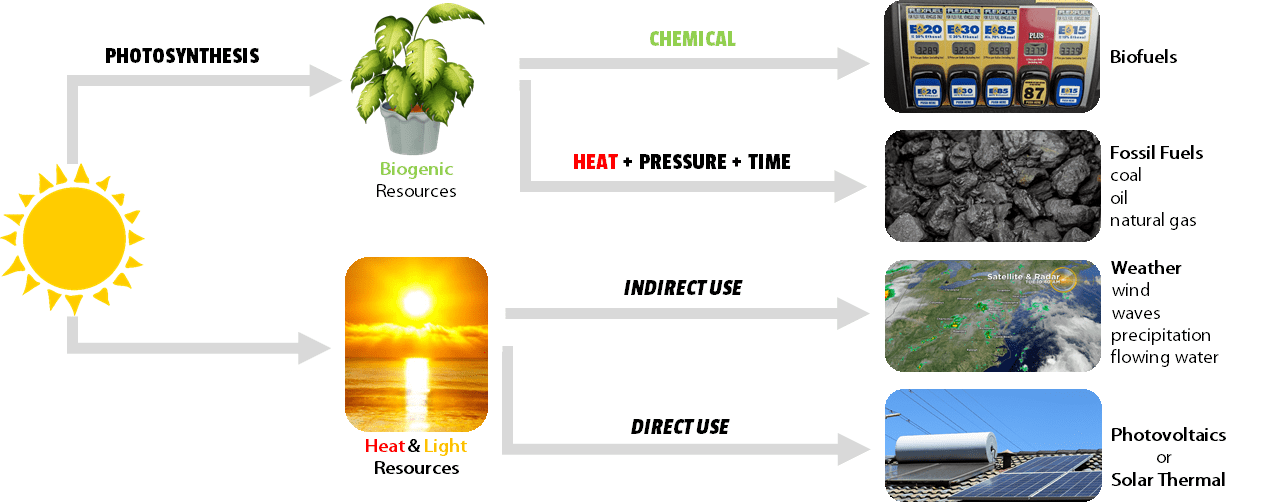
Another primary source of energy is the Earth itself. Contained within the Earth are minerals like uranium (which is used in the nuclear energy industry), while geothermal energy originates from the heat contained within the Earth. Another form of primary energy is related to the Earth's movement, as well as satellite movement within the solar system. For example, the moon moves around the Earth, which is partially responsible for tides and tidal energy. The force of gravity resulting from Earth's orbit and attraction to the Sun may provide some forms of energy that we can also use. Several examples of primary energy sources derived from the Earth and its movement are depicted in Figure 3.
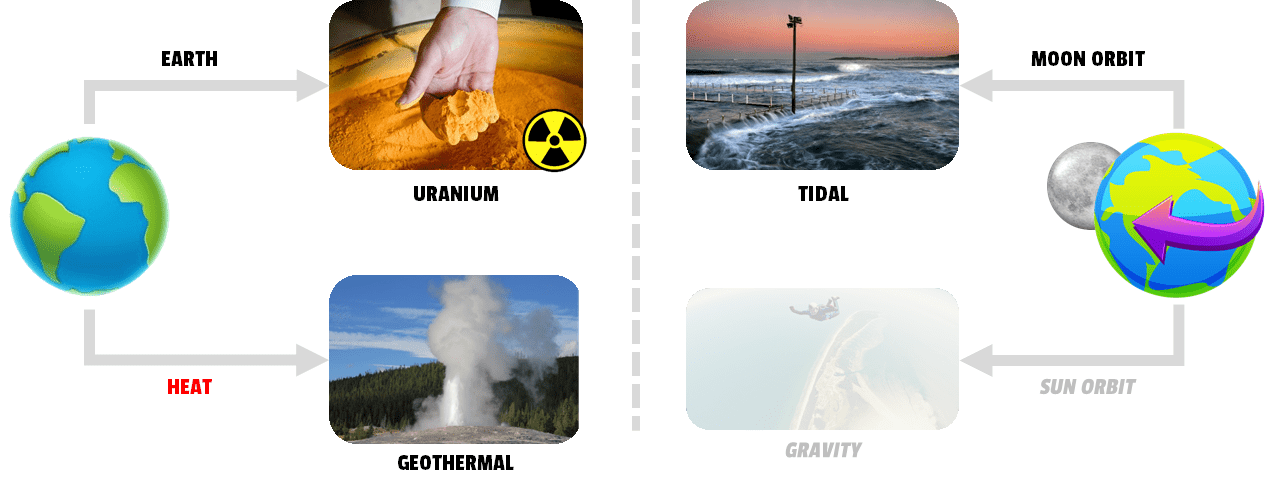
The energy that we use in our homes, farms and businesses is typically supplied to us as either heat or electricity, the latter of which is generated by solar photovoltaics. Electricity is an important form of energy which can be converted into virtually any other form of energy including heat, light, or chemical energy. Consider how the electricity that you use in your home, farm, or business. This electricity can easily be converted into different forms of energy including light energy through the use of a lamp, heat energy using an electric baseboard, or even chemical energy that is stored inside a rechargeable battery. Since photovoltaics involves the creation of electricity from solar energy–and considering these diverse applications of electricity–the generation of electricity will be further explored in this unit of the handbook.
Electricity is traditionally created using a generator. On a basic level, a generator works by moving magnets and a copper wire across one another. This movement creates an induced current of flowing electrons through the wire. Larger quantities of electricity can be generated by connecting the generator to a turbine, which is a simple device where motion is generated and captured from a moving fluid like air, water, or steam. As the turbine spins, the magnet and wire move against one another more rapidly. The fluid used to move the turbine often defines the type of energy that's used. For example, a steam generator uses boiling water to create the high pressure steam which spins the turbine. The energy needed to boil the water can come from a fossil fuel source, a nuclear fission, or geothermal heat. While those energy sources are used only to generate steam, steam is not the only fluid that could be used to turn a turbine. Wind or water turbines could also be used to generate electricity as indicated in Figure 4.
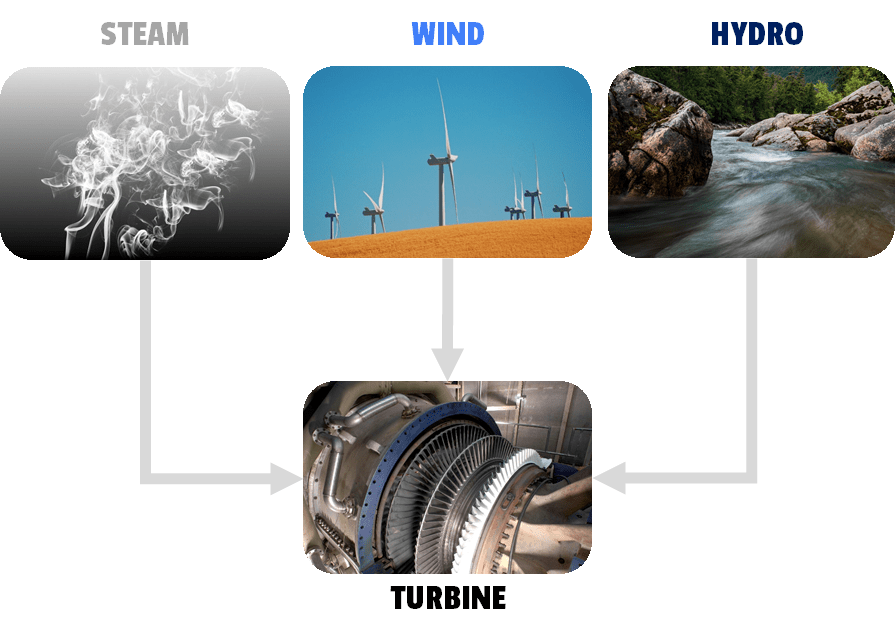
Renewables & Non-Renewables
To understand the role that solar photovoltaics plays in Maryland’s energy market, we’ll start by considering the state’s energy sector as a whole. While Maryland ranks among the 10 lowest states in per capita energy consumption13, as well as energy-intensity,14 the state currently consumes more than five times as much energy as it produces.11 The transportation, residential, and commercial sectors each consume about three-tenths of the energy used in the state, while the industrial sector (which includes agriculture) consumes approximately one-tenth.12 This energy is derived from many different sources, but in the broadest sense, we’ll consider both non-renewable, as well as renewable resources (see Figure 5).
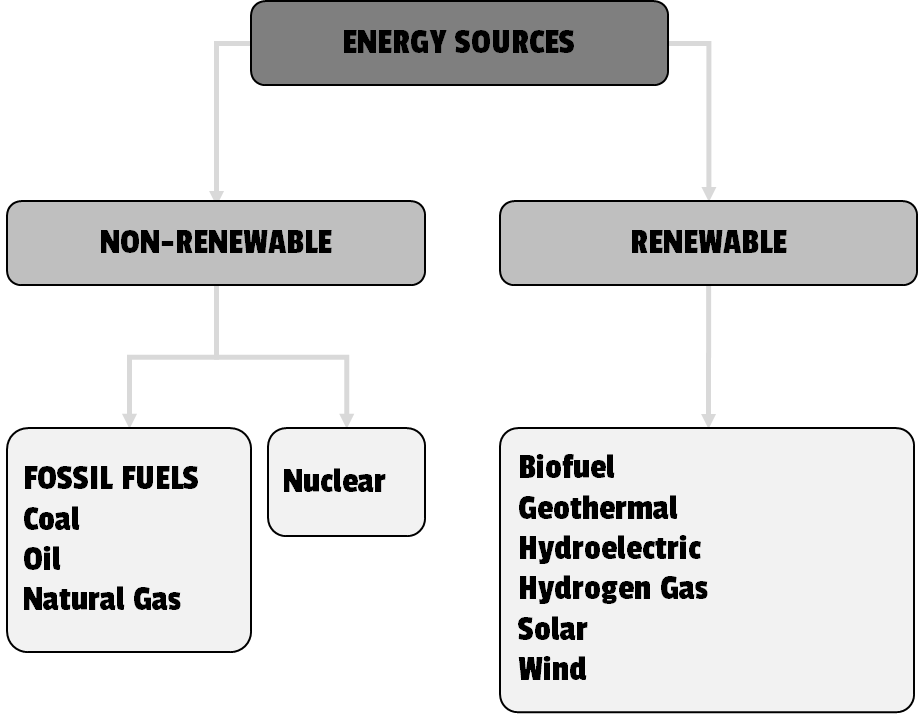
The Sun produces the largest amount of energy over one year compared to all the other forms of energy combined, both renewable and non-renewable (see Table 1). While traditional energy forms, like fossil and nuclear, decline as their reserves are use, the size of the solar resource remains constant year after year.
| World Energy Use | TWy/y | Renewables | TWy/y | |
|---|---|---|---|---|
| 2015 | 18.5 | Solar | 23,000 | |
| 2050 | 28 | Wind | 75 - 130 | |
| OTEC | 3 - 11 | |||
| Finite Resources | TWy | Biomass | 2 -6 | |
| Coal | 830 | Hydro | 3 - 4 | |
| Petroleum | 335 | Geothermal | 0.2 - 3.0+ | |
| Natural Gas | 220 | Waves | 0.2 - 2.0 | |
| Uranium | 185+ | Tidal | 0.3 |
Maryland's Energy Market
Most of the energy consumed in Maryland comes from nonrenewable energy sources, including uranium ore and fossil fuels. As of 2018, the top three energy sources consumed in the state are petroleum (33%), natural gas (23%), and nuclear electric power (12%) as shown in Figure 6. These non-renewable energy sources cannot be made or "renewed" easily. In other words, the supply of non-renewable energy sources is limited by how much we can mine or extract from the earth. Many of these non-renewable resources are also associated with major environmental impacts including carbon dioxide emissions from fossil fuels or radioactive waste from nuclear sources. With that said, nuclear and fossil fuels are dispatchable. This means their supply can easily be varied based on the actual amount of electricity needed at any given time.
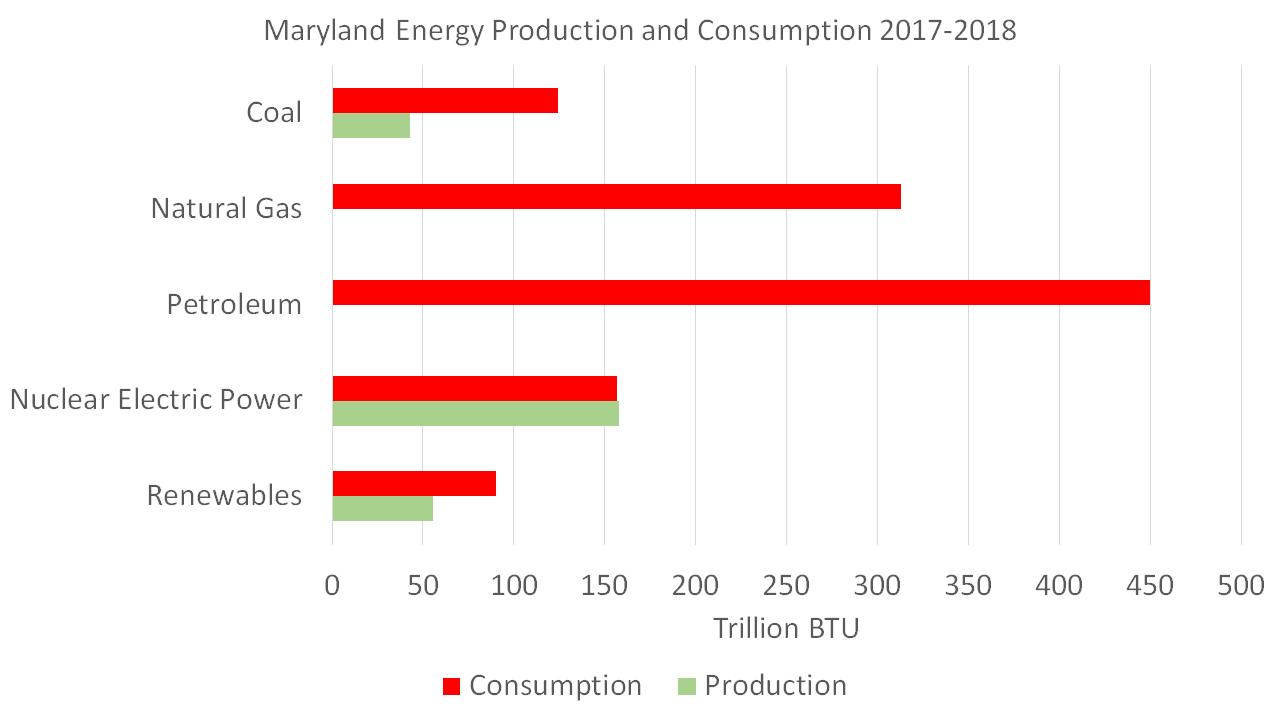
In terms of energy resources, Maryland has no economically recoverable crude oil reserves or production, and there are no petroleum refineries in the state. For these reasons, petroleum products arrive in Maryland by pipeline from other states and by ship from abroad. Similarly, the state has few economically recoverable natural gas reserves and produces very little natural gas. Although Maryland's westernmost counties overlie part of the natural gas-rich Marcellus Shale, the state enacted a permanent ban on using hydraulic fracturing in 2017. Instead, Maryland's natural gas needs are met by supplies that enter the state by way of several interstate pipelines and a liquefied natural gas (LNG) input terminal. While Maryland only accounts for about 0.2% of U.S. coal production, about 25% of the coal mined within the state is burned at industrial facilities.
Maryland’s energy resources are used in various ways to support different sectors of the state. While about 90% of Maryland’s petroleum is consumed by the transportation sector, smaller quantities are used by the industrial (~6%) residential (~2%) and commercial (~2%) sectors. The residential and commercial sectors each account for about one-third of the state's natural gas consumption with 40% of Maryland households using natural gas as their primary fuel for heating. While natural gas is not commonly used in
agricultural operations since it’s typically delivered via pipeline, it is commonly used as an input for agriculture-related products, such as nitrogen fertilizers. Another 12.5% Maryland households use fuel oil or kerosene for heating. In any case, fuel prices will typically fluctuate based on delivery costs, storage, forward contracting and other factors. Propane is also used for space heating (49%), water heating (16%), cooking (6%), and other uses (29%) within Maryland homes. Agricultural operations may also use propane for livestock barn heaters or water heating in dairy barns. The price of these fuels will typically follow petroleum pricing since their production is linked to petroleum extraction and refining.
The electric power sector accounts for nearly one fourth of the state’s natural gas consumption while contributing to around 33% of Maryland's net electricity generation (see Figure 7). Coal-fired generating plants historically supplied more than half of Maryland's net electricity generation while using about 75% of the coal mined within the state. However, the shares of coal-fired electricity generation fell to 14% in 2019 as natural gas-fired generation increased (see Figure 8). With that said, the majority of Maryland's remaining coal-fired power plants are aging, with decommissioning plans on the horizon for several units. Maryland's only nuclear power plant, which is located on the western shore of the Chesapeake Bay (Calvert Cliffs), accounted for 34% of the state's electricity net generation in 2018.

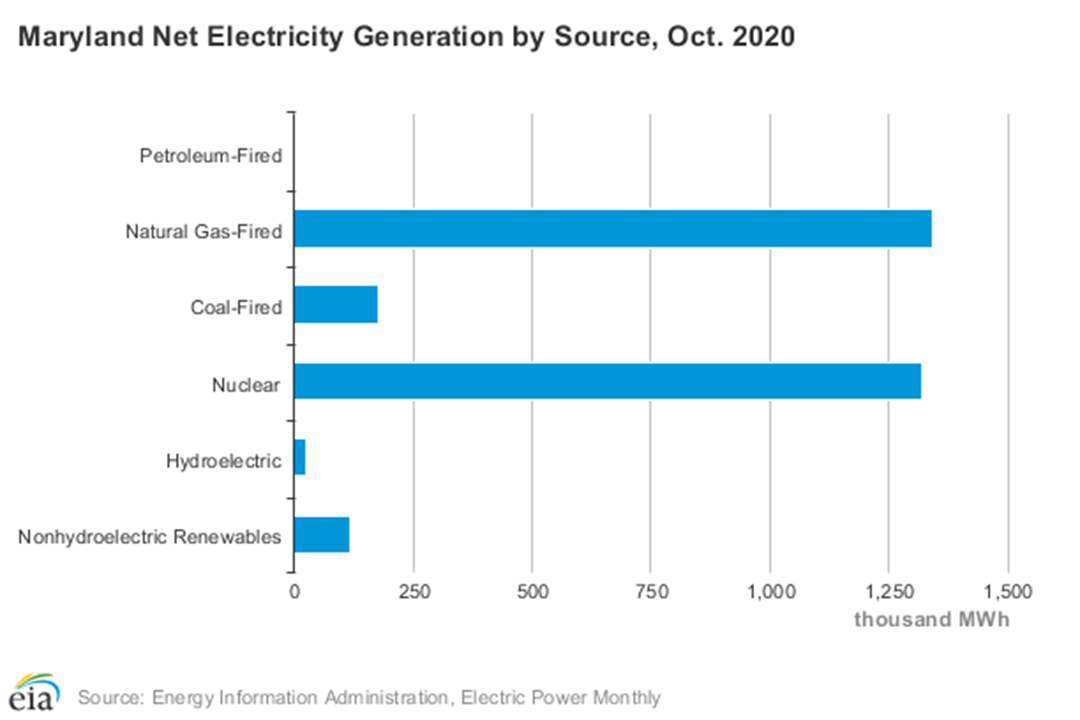

Renewable energy sources are those that are naturally replenishing but flow-limited. These resources are virtually inexhaustible in duration but limited in the amount of energy that is available per unit of time. Renewable energy relies upon ongoing natural cycles (such as solar radiation, rain, or Earth’s internal heat) as opposed to stored fossil energy created over long periods of time. While Maryland's renewable energy resources are widely distributed across the state, they currently provide around 14.5% of in-state net electricity generation. In 2019, the top three renewable energy sources in Maryland in terms of net generation were hydropower, solar, and wind (see Figure 10); although other energy sources and their derivatives are used in the state to a lesser extent.

Biomass (e.g., wood, agricultural crops, municipal garbage) can be converted into biogas or biofuels (e.g., ethanol and biodiesel) or burned directly to produce heat or steam. The combustion process is similar to using a fossil fuel, but the original biomass fuel is grown through photosynthesis and can be considered carbon neutral. While biomass can be easily stored and transported, it has the potential to compete with food crops and typically has multi-year growth cycles. Biomass was used to generate about one-tenth of Maryland's renewable electricity in 2018 at facilities using landfill gas, municipal solid waste, and wood and wood waste. About 80% of the state's total biomass capacity comes from two facilities using municipal solid waste.
Hydropower, or hydroelectric power, uses a direct mechanical to electrical conversion as water turns a turbine. Although hydroelectric resources are somewhat dispatchable with water stored behind a dam, they do require significant mechanical maintenance and cause at least some ecological disturbance. Seasonal and long-term variations in precipitation, such as droughts, can also have large effects on hydropower production. Hydropower currently accounts for more than half of Maryland's renewable electricity generation, with the Conowingo hydroelectric generating station accounting for most of Maryland's hydroelectricity. Flowing streams, irrigation ditches, and existing pipelines are the most likely locations for small hydropower systems that can offset home or farm/ranch energy consumption.
Solar energy can either be collected as solar thermal (heat) energy or converted into electricity. Solar thermal energy systems are commonly used to heat water (homes, buildings, or swimming pools), indoor air (homes, greenhouses, and other buildings), and high-temperature fluids (solar thermal power plants). Solar thermal systems will not be discussed much further since primary focus of this handbook is on electrical generation. Direct solar-to-thermal systems are one technology for electrical conversion which generates steam from a superheated fluid in order to turn a turbine. However, this technology requires a lot of direct cloud-free sunlight for many hours each day throughout the year. The other way that solar energy can be used is the direct conversion of solar energy to electricity using photovoltaics (PV) which is the subject of this handbook. The word photovoltaic comes from the Greek word photo, meaning light, and Volta, named after Alessandro Volta, who was a pioneer in electrical energy and invented the electrical battery. So, the word of photovoltaic implies light to electricity.
Solar energy currently provides about one-fourth of Maryland's renewable electricity generation, and increased significantly in recent years, nearly tripling from 2016 to 2018 (see Figure 15). Two-thirds of the state's solar generation came from small-scale solar photovoltaics (PV), such as rooftop systems, and the rest of the generation was at larger utility-scale sites like solar farms. By early 2019, Maryland had nearly 1,100 megawatts of solar generating capacity installed. However, a 25% decline in 2020 residential markets has been expected, followed by a 26% increase in 2021 as the solar photovoltaic market begins to experience tepid recovery. Coronavirus impacts on the non-residential market will be more evenly spread throughout the year due to the longer development timelines of the former category of projects (see Figure 16). Accordingly, the near-term impact of the coronavirus pandemic on non-residential solar will result in significant project delays in 2020, resulting in a 38% decline from 2019 volumes. Delayed projects will spill into 2021, leading to a 49% increase over 2020, but still well below both 2019.


Wind power is a direct mechanical to electrical conversion source which uses a free fuel source (i.e., wind), but only functions when the wind is active. The conversion device itself (i.e., wind turbine) requires a relatively small footprint for installation. While windmills are still operated on some farms and ranches to supply water for livestock, modern applications of wind energy are mainly used for electricity generation. In fact, wind energy provided about 10% of Maryland's renewable electricity generation in 2018. While almost 200 megawatts of utility-scale wind farms are currently being operated along Maryland's western Appalachian Mountain crests, Maryland's largest wind energy potential is offshore. Two major wind projects are currently planned off Maryland's Atlantic coastline including a 250 MW and a 120 MW project located 17 and 20 miles offshore, respectively.
Geothermal power, on the other hand, uses Earth's heat to generate electricity or heat. While the fuel source is free, there are very few places on the globe that have sufficient geothermal resources to make this technology more prevalent. In Maryland, geothermal heat pumps (GHSPs) are commonly used to heat and cool buildings using the near constant temperature within the ground. GHSPs are very different from combustion appliances since the heat pump transfers heat from the ground to a building through the use of a circulating fluid. It may be noted here, that GSHPs rely on electricity to operate the compressor and pump to facilitate this heat transfer.
Now that we’ve highlighted Maryland’s diverse energy landscape, we will take a closer look at how the solar photovoltaics market is growing across the state.
Other units in this module:

| Maryland's Solar Market Length: 55:14 Date: September 30, 2020 Dr. Drew Schiavone Download Slide Deck (pdf) |